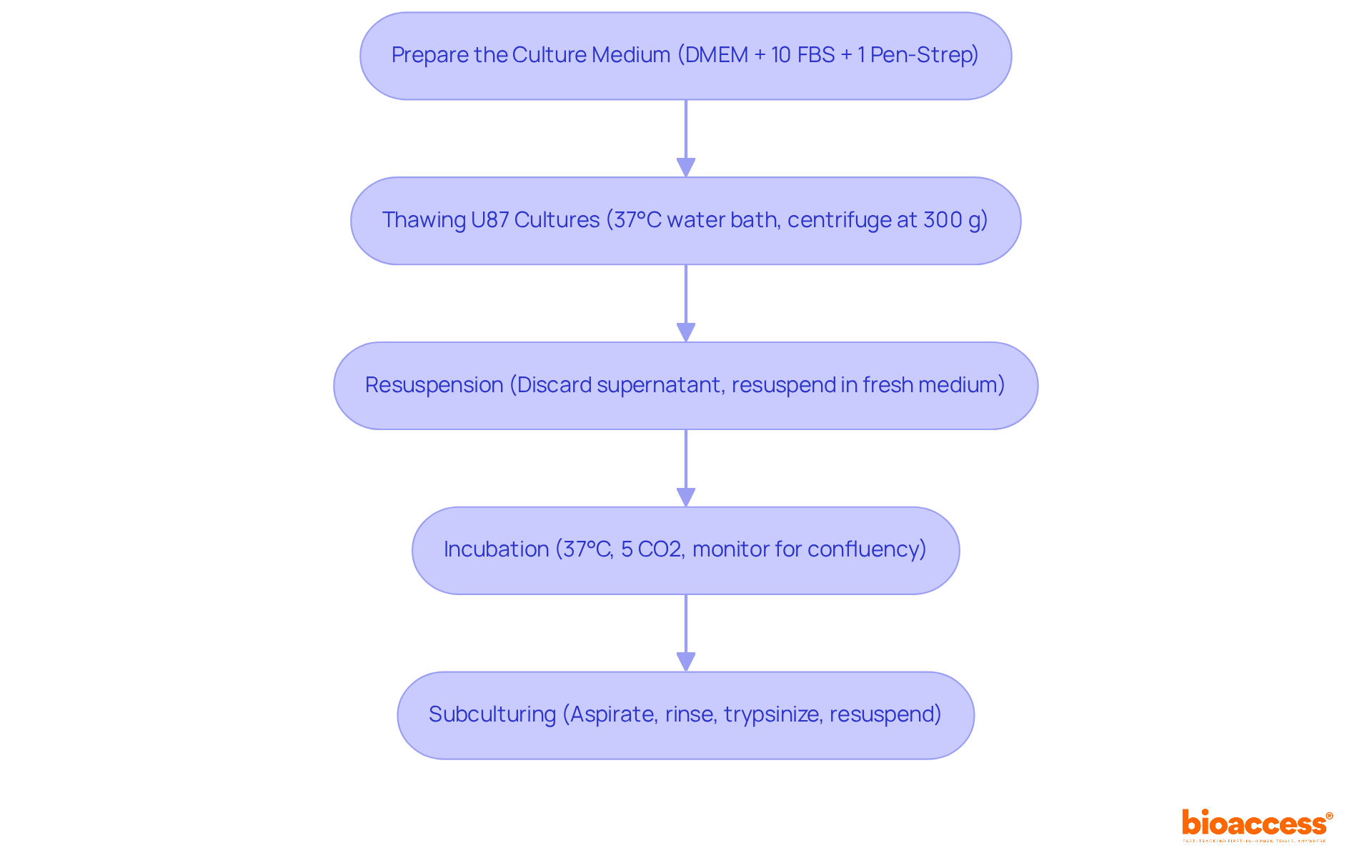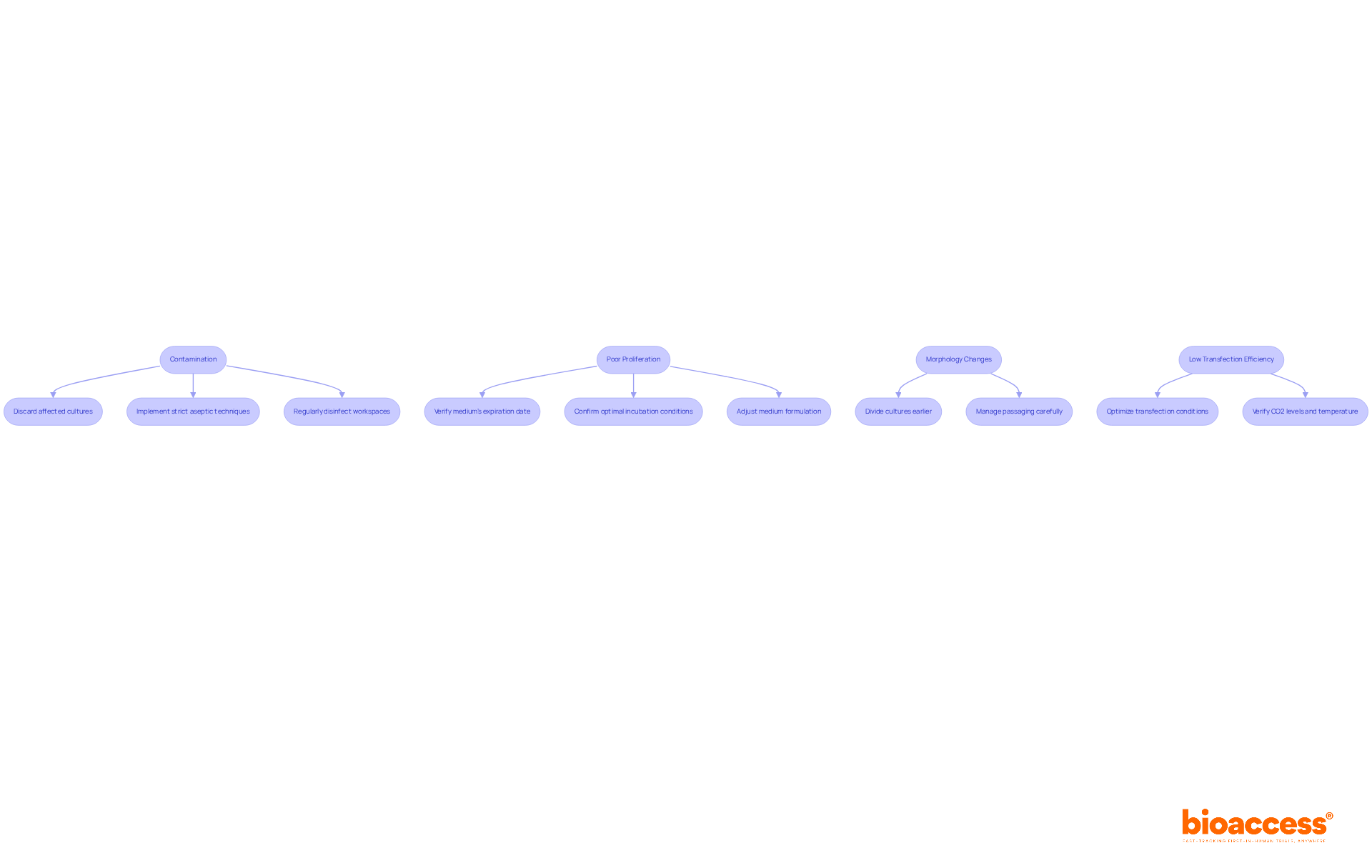


The article serves as a comprehensive guide on the cultivation and applications of U87 cell lines, which are pivotal for glioblastoma research. It presents detailed, step-by-step protocols for their cultivation, elucidates their significance in drug testing and gene expression studies, and addresses common challenges researchers may face. By highlighting the critical role of U87 cell lines, the article underscores their importance in advancing cancer treatment strategies.
U87 cell lines stand at the forefront of cancer research, particularly in the study of glioblastoma, one of the most aggressive brain cancers. Their unique ability to mimic tumor characteristics renders them indispensable for testing new therapies and understanding tumor biology. However, effectively cultivating these cell lines presents challenges that can significantly impact research outcomes.
How can researchers ensure optimal growth and application of U87 cell lines to maximize their potential in advancing cancer treatment?
U87 cell lines, which are derived from human brain tumors, are pivotal in cancer research due to their capacity to replicate the characteristics of brain malignancies. The u87 cell lines are vital for researchers focused on glioblastoma, a notably aggressive form of brain cancer. U87 cell lines serve as a fundamental resource for:
Their significance is underscored by their reproducibility and the extensive data available, establishing them as a benchmark model in preclinical studies.
Recent studies reveal that u87 cell lines exhibit unique development patterns and tumorigenic behavior, with late passage samples showing diminished invasive characteristics compared to their early passage counterparts. Moreover, research indicates that the combination therapy of solid lipid curcumin particles and berberine significantly enhances apoptotic death and DNA fragmentation in u87 cell lines, emphasizing their role in evaluating potential cancer treatments. As highlighted in various studies, the u87 cell lines are not only well-defined in terms of development and morphology but also serve as a reliable platform for drug screening and testing, rendering them essential in the ongoing battle against glioblastoma.

Prepare the Culture Medium: Begin by utilizing DMEM (Dulbecco's Modified Eagle Medium) enriched with 10% fetal bovine serum (FBS) and 1% penicillin-streptomycin. It is crucial to ensure sterility throughout the preparation process to maintain the viability of the organisms. Recent research underscores that maintaining consistent culture conditions is essential for optimal growth of the organisms.
Thawing U87 Cultures: Quickly thaw frozen U87 cultures in a 37°C water bath. Immediately transfer the thawed specimens to a centrifuge tube containing 10 mL of pre-warmed culture medium. Centrifuge at 300 g for 5 minutes to effectively eliminate DMSO, which can be detrimental to the organisms. According to ATCC guidelines, this step is vital to prevent mortality during the thawing process.
Resuspension: Carefully discard the supernatant and resuspend the pellet in 5 mL of fresh culture medium. Transfer this suspension to a T-25 flask, ensuring even distribution for optimal development. Studies indicate that U87 cell lines typically form loosely connected groups, which can significantly influence their developmental dynamics.
Incubation: Position the flask in a 37°C incubator with a 5% CO2 atmosphere. Consistently monitor the cultures for confluency, striving for a growth rate that fosters healthy proliferation. Daily checks are recommended, as U87 cell lines can reach confluency rapidly under optimal conditions.
Subculturing: When cultures attain 70-80% confluency (usually every 3-4 days), aspirate the medium, rinse with PBS, and introduce 0.25% trypsin-EDTA to detach the cultures. Following detachment, neutralize with fresh culture medium, centrifuge, and resuspend in new medium for continued culturing or experimentation. This approach ensures a high success rate in preserving viability and function, which is essential for reliable research outcomes. As emphasized by Burcu ÇERÇİ ALKAÇ, the combination of appropriate handling and media formulation significantly impacts the efficacy of therapies on glioblastoma.

U87 cell lines play a critical role as a versatile tool in various experimental contexts, significantly advancing clinical research. Their applications include:
Drug Testing: U87 cultures are pivotal for evaluating the efficacy of new chemotherapeutic agents. Researchers treat these entities with medications and assess viability using tests like MTT or Annexin V staining. Notably, studies have demonstrated that mono-therapies with cisplatin and temozolomide (TMZ) reduced the viability of u87 cell lines to 38% and 24%, respectively, after three days under normoxia. This underscores their utility in drug efficacy assessments. The IC50 values for cisplatin and TMZ under normoxic conditions are 3µM and 1mM, respectively, providing essential context for these results. Furthermore, combination therapies with PN517 and cisplatin significantly diminished the viability of u87 cell lines to 18%, showcasing the effectiveness of this approach.
Gene Expression Studies: U87 lines are extensively utilized to explore the effects of gene knockdown or overexpression. Techniques such as siRNA transfection or CRISPR-Cas9 enable researchers to manipulate gene expression, facilitating insights into the molecular mechanisms underlying glioblastoma. The uniform characteristics of u87 cell lines, which have a consistent genetic composition, enhance the reliability of these studies. Moreover, findings related to the down-regulation of MDR-1 and its correlation with patient survival outcomes underscore the importance of these investigations.
Tumor Microenvironment Research: Co-culturing U87 lines with other cell types, including immune components, allows for the examination of interactions within the tumor microenvironment. This method is vital for understanding how brain tumor entities respond to immune challenges and treatment strategies, offering a comprehensive view of tumor biology.
In Vivo Studies: Implanting U87 tissues into animal models enables researchers to investigate tumor growth and metastasis in a living organism. This approach provides valuable insights into brain tumor progression and treatment responses, contributing to the development of more effective therapeutic strategies. The use of u87 cell lines in these contexts underscores their significance in advancing cancer research and treatment development. As Dr. Philip Welsby noted, the prognosis for glioblastoma multiforme (GBM) remains unfavorable, highlighting the necessity for efficient drug testing approaches that utilize u87 cell lines. The application of statistical analysis methods, such as single-factor ANOVA, further enhances the credibility of the findings presented.

Contamination: In the event of contamination, it is imperative to promptly discard the affected cultures. Contamination rates in tissue culture studies can be significant, underscoring the necessity for vigilance. Implementing strict aseptic techniques and regularly disinfecting workspaces is essential to prevent future occurrences.
If U87 cell lines exhibit poor proliferation, it is crucial to verify the medium's expiration date and confirm that incubation conditions are optimal (37°C, 5% CO2). The ideal concentration for freezing U-87-MG units should fall within the range of 1x10^5 - 1x10^6 units/ml. Modify the medium formulation as necessary, as variations can significantly influence viability and growth rates.
Morphology Changes: If the structures appear rounded or detached, this may indicate over-confluence or stress. Research indicates that late passage u87 cell lines can display altered morphology and reduced tumorigenicity. To mitigate this, cultures should be divided earlier, and careful management during passaging is essential to sustain optimal culture conditions.
Low Transfection Efficiency: To enhance transfection efficiency, it is advisable to optimize conditions by adjusting reagent ratios or exploring alternative transfection methods. Additionally, verifying that CO2 levels and temperature in the incubator are suitable for u87 cell lines is critical. Addressing these common issues through systematic troubleshooting can significantly improve the reliability of u87 cell lines research.

In conclusion, the role of U87 cell lines in cancer research is paramount. They are not merely a vital tool for understanding glioblastoma; they also serve as a platform for innovative therapeutic strategies. Researchers must adopt best practices and stay abreast of the latest developments in U87 cell line applications to maximize their contributions to the scientific community. The ongoing exploration of these cell lines is poised to yield breakthroughs that will significantly enhance our understanding and treatment of brain tumors. Thus, the commitment to utilizing U87 cell lines effectively is essential for advancing cancer research and improving patient outcomes.
What are U87 cell lines and where do they originate from?
U87 cell lines are derived from human brain tumors and are pivotal in cancer research due to their ability to replicate the characteristics of brain malignancies.
Why are U87 cell lines important for cancer research?
U87 cell lines are important because they are vital for researchers focused on glioblastoma, an aggressive form of brain cancer. They serve as a fundamental resource for testing therapeutic strategies, elucidating tumor biology, and assessing drug efficacy.
What makes U87 cell lines a benchmark model in preclinical studies?
Their significance is underscored by their reproducibility and the extensive data available, which establish them as a benchmark model in preclinical studies.
How do U87 cell lines behave differently at various passages?
Recent studies show that U87 cell lines exhibit unique development patterns and tumorigenic behavior, with late passage samples displaying diminished invasive characteristics compared to early passage samples.
What recent findings have been reported regarding potential cancer treatments using U87 cell lines?
Research indicates that the combination therapy of solid lipid curcumin particles and berberine significantly enhances apoptotic death and DNA fragmentation in U87 cell lines, highlighting their role in evaluating potential cancer treatments.
In what ways are U87 cell lines utilized in drug testing?
U87 cell lines are well-defined in terms of development and morphology, making them a reliable platform for drug screening and testing, which is essential in the fight against glioblastoma.